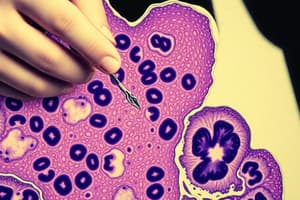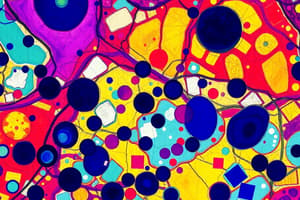Podcast
Questions and Answers
What is one of the primary functions of the basement membrane?
What is one of the primary functions of the basement membrane?
- Molecular filtering (correct)
- Nerve impulse transmission
- Nutrient absorption
- Gas exchange
What type of junction is indicated if a population of cells shows positive staining for the protein connexin?
What type of junction is indicated if a population of cells shows positive staining for the protein connexin?
- Adherens junctions
- Gap junctions (correct)
- Tight junctions
- Desmosomes
If an individual cannot synthesize normal occludin, what situation would likely be affected?
If an individual cannot synthesize normal occludin, what situation would likely be affected?
- Nutrient absorption rates
- Signal transmission between neurons
- Blood flow through tissues
- Material crossing the epithelium between the cells (correct)
Which protein is primarily found in the cytoplasm of most epithelial cells and is classified as an intermediate filament?
Which protein is primarily found in the cytoplasm of most epithelial cells and is classified as an intermediate filament?
What cellular feature is important in classifying different types of epithelia?
What cellular feature is important in classifying different types of epithelia?
What is the primary function of fluorescent stains like acridine orange and DAPI?
What is the primary function of fluorescent stains like acridine orange and DAPI?
Which microscopy technique is best suited for producing high-resolution images of tissue surfaces?
Which microscopy technique is best suited for producing high-resolution images of tissue surfaces?
What advantage does confocal microscopy have over traditional microscopy methods?
What advantage does confocal microscopy have over traditional microscopy methods?
How does differential interference microscopy enhance the visibility of cellular structures?
How does differential interference microscopy enhance the visibility of cellular structures?
What is the purpose of autoradiography in cellular studies?
What is the purpose of autoradiography in cellular studies?
Flashcards are hidden until you start studying
Study Notes
Tissue Staining and Microscopy
- Hematoxylin and eosin (H&E) staining is a common technique for examining basic tissue structure, staining nuclei blue and cytoplasm pink
- Periodic acid-Schiff (PAS) reaction stains carbohydrate-rich tissue structures, making them visible
- Fluorescence microscopy uses UV light to make fluorescent substances appear bright against a dark background. This technique allows for visualization of nucleic acids and cell nuclei using fluorescent stains like acridine orange and DAPI
- Phase-contrast microscopy makes transparent objects, including living cells, visible by utilizing changes in light speed to enhance the visibility of cellular structures
- Differential interference microscopy with Nomarski optics provides a more apparent 3D perspective of living cells
- Confocal microscopy achieves high resolution and sharp focus by using a small point of high-intensity light and a pinhole aperture, allowing for the creation of optical sections by capturing digital images at different focal planes
- Polarizing microscopy aids in identifying highly organized subunits within stained or unstained structures based on their ability to rotate the plane of polarized light
Transmission Electron Microscopy (TEM)
- Provides high-resolution images of tissue sections by passing electrons through the sample
- Allows for visualizing cellular ultrastructure at the nanoscale level, revealing details like membranes, organelles, and proteins
Scanning Electron Microscopy (SEM)
- Provides high-resolution images of cell and tissue surfaces using a narrow electron beam and a metal-coated specimen
- Produces black-and-white images that present a three-dimensional view of surfaces with highlights and shadows
Microscopic Autoradiography
- Localizes newly synthesized macromolecules using radioactive labels
- Helps identify replicating cells and track protein migration
Cell and Tissue Culture
- Allows for the observation of cellular behavior outside the body in controlled environments
- Cultured cells are grown in solutions with known compositions and can be maintained for extended periods
Enzyme Histochemistry
- Localizes cellular structures based on their specific enzymatic activity
- This technique uses specific compounds or macromolecules to detect and localize sugars, proteins, and nucleic acids in tissues
Epithelial Tissue
- Forms cellular sheets that line organ cavities and cover the body surface
- Plays a role in covering, lining, and protecting surfaces, absorption, and secretion
- Some epithelial tissues have specialized cells, such as contractile myoepithelial cells or sensory cells in taste buds or olfactory epithelium
Connective Tissue
- Provides physical support and connection between cells and organs
- Composed primarily of extracellular matrix (ECM) rather than cells
- ECM consists of protein fibers (collagen and elastic fibers) and ground substance
- Ground substance includes proteoglycans, glycosaminoglycans (GAGs), and glycoproteins
Muscle Tissue
- Specialized for contraction and movement
- Three types: smooth, skeletal, and cardiac muscle
- Smooth muscle: Small, fusiform cells linked by gap junctions, lacks sarcomeres and striations, contraction is controlled by dense bodies and α-actinin
- Skeletal muscle: Striated, multinucleated fibers, allows for voluntary movements
- Cardiac muscle: Striated, branched cells connected by intercalated discs
Nervous Tissue
- Specialized for receiving and transmitting nerve impulses
- Composed of neurons and glial cells
- Neurons transmit electrical signals via axons and dendrites
Organs
- Composed of parenchyma and stroma
- Parenchyma consists of specialized cells responsible for the organ's primary function
- Stroma consists of connective tissue cells that provide support
Circulatory System
- Pumps and directs blood throughout the body
- Composed of the heart, arteries, capillaries, and veins
- Heart: Four chambers, consisting of endocardium, myocardium, and epicardium
- Arteries: Carry blood away from the heart
- Capillaries: Facilitate the exchange of oxygen, carbon dioxide, nutrients, and waste products between blood and tissues
- Veins: Carry blood back to the heart
Lymphatic System
- Collects and returns fluid from tissues to the blood
- Helps maintain fluid balance and protect against infection
Blood
- Connective tissue composed of cells and plasma
- Circulates unidirectionally within the closed circulatory system
- Formed elements: Erythrocytes (red blood cells), leukocytes (white blood cells), and platelets
- Plasma: Aqueous solution containing plasma proteins, nutrients, gases, waste products, hormones, and electrolytes
Erythrocytes
- Red blood cells, filled with hemoglobin, lack a nucleus, and have a biconcave shape
- Lack mitochondria and nuclei
- Rely on anaerobic glycolysis for energy
- Survive for about 120 days in circulation
Leukocytes
- Play a critical role in defending against infection and inflammation
- Divided into granulocytes (neutrophils, eosinophils, and basophils) and agranulocytes (lymphocytes and monocytes)
- Involved in immune responses, such as phagocytosis, antibody production, and inflammation
Platelets
- Cell fragments involved in blood clotting
Hemopoiesis
- Occurs in the bone marrow
- Involves pluripotent stem cells that differentiate into various blood cells
- Progenitor cells differentiate with specific growth factors (CSFs or cytokines) in microenvironmental niches
- Red bone marrow: Active in hemopoiesis, contains erythropoietic islands
- Yellow bone marrow: Mostly adipose tissue
Erythropoiesis
- The process of red blood cell production
- Involves cell differentiation, nucleus extrusion, and hemoglobin synthesis
Granulopoiesis
- The process of granulocyte production
- Involves various stages, such as myeloblasts, promyelocytes, myelocytes, and metamyelocytes
Monocytopoiesis
- The process of monocyte production
- Involves monoblasts differentiating into monocytes
Lymphopoiesis
- The process of lymphocyte production
- Involves lymphoblasts differentiating into lymphocytes
Thrombopoiesis
- The process of platelet production
- Involves megakaryocytes producing platelets through proplatelet formation
Studying That Suits You
Use AI to generate personalized quizzes and flashcards to suit your learning preferences.




